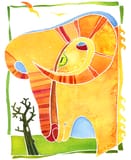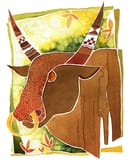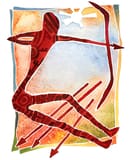A Cusp is the dividing line between signs or chart houses. It distinguishes where one sign or house ends and the next one begins.
Sign Cusps
The beginning point of a Zodiac sign is called the Cusp. It marks the dividing line between that sign from the preceeding one. Think of it like a doorway or entrance into that sign. The illustration shows lines radiating from the centre of the wheel, each of which indicates the cusp of a sign. The lines around the outer edge of the circle show the area of that sign.
When someone is born in the last day or two before the Sun changes signs, or perhaps in the first day or so after entering a new sign, it is often called being "born on the cusp." Some astrologers interpret this to mean the person has qualities of both signs, which many "cusp" people relate to. Other astrologers attribute this experience of relating to both signs to other factors, like where other planets are in their chart. For example, since Mercury is always in the same, previous or next sign as the Sun, and Venus is always within 2 signs of the Sun's sign, so if one or both are in the second sign, it could explain why "cusp" people are sensitive to both signs.
In the case of traditional Zodiac signs, the arc between sign cusps is always 30 degrees. Some astrologers sometimes work with constellations, which are widely varied in terms of the number of degrees between cusps.
House Cusps
The beginning point of a house in a chart is called the Cusp. It marks the dividing line between that house from the preceeding one. Think of it like a doorway or entrance into that house. The illustration shows lines radiating from the centre of the wheel, each of which indicates the cusp of a house. The lines around the outer edge of the circle show the area of that house.
Many astrologers and astrology systems consider that if a planet is within about 5 or 6 degrees of the next house cusp, it is interpreted as being in the next house.
The number of degrees between house cusps varies dramatically depending on (a) which house system is being used, and (b) the location that the chart is calculated for. For example, Equal houses and Whole Sign houses are always 30* while other house systems typically use elaborate calculations to determine the sign and degree for each cusp. House systems calculate the position of house cusps in different ways.
There's always a certain amount of distortion that happens when we map the 3-dimensional sky onto a 2-dimensional piece of paper, and this distortion becomes extreme when a chart is calculated for the extreme north or south regions. As a result, some house systems wind up calculating houses that are sometimes more than 2 signs wide (over 60 degrees) or barely a sliver of a sign (just a few degrees). As a result, equal house systems are often used for extreme latitude locations.
Another implication of this distortion is interception which is when a sign is wholely encased within a house and no house cusp intersects that sign. This also affects house rulership in charts. Astrologers have different views about how important or significant interceptions are.














